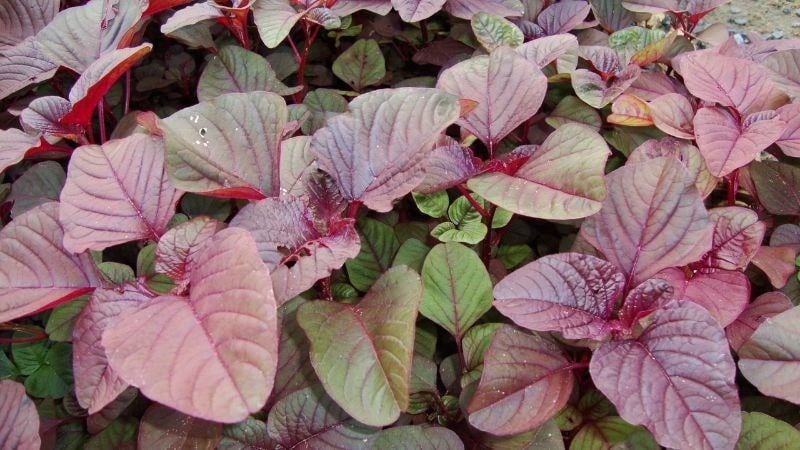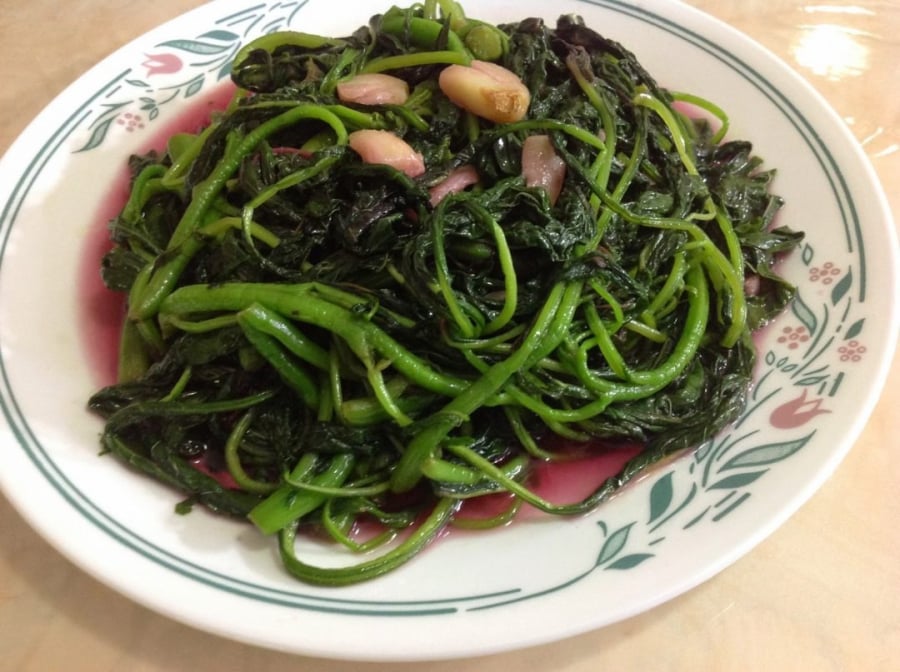Amaranth, with its popular varieties such as red, white, and grain amaranth, has long been a familiar dish on Vietnamese tables. The leaves are soft, with a gentle sweetness, and are often eaten raw, cooked in soups, or stir-fried with garlic, always delicious. But few know that behind this humble exterior lies a treasure trove of nutrition that even the most expensive superfoods can hardly match.
Amaranth is packed with vitamins A and C, iron, calcium, and antioxidants, promoting overall health and well-being. In rural areas, amaranth grows wild along rice fields and pond banks, requiring minimal care. Despite its incredibly low price, ranging from just 3,000 to 5,000 VND per bundle, many people don’t bother to pluck it from their gardens. However, the true value of amaranth lies not in its monetary worth but in its exceptional ability to enhance one’s health, earning it the moniker of “commoner’s panacea.”

Amaranth for Blood Health
One of the standout benefits of amaranth is its ability to support blood circulation and combat anemia. With its high iron content, amaranth boosts red blood cell production, alleviating fatigue and dizziness associated with anemia. Notably, this vegetable also contains folic acid, crucial for pregnant women as it supports the healthy development of the fetus.
Thus, amaranth is comparable to ginseng, a prized medicinal herb renowned for its blood-boosting properties. A bowl of amaranth soup cooked with shrimp or crab is not only delicious but also serves as a natural energizer. For those experiencing work-related stress or postpartum women, amaranth provides a simple yet effective means of nourishing the body without breaking the bank.
Cooling and Detoxifying
During the sweltering summer months, our bodies are prone to heat-induced issues like mouth ulcers, inflammation, and fatigue, leading to toxin buildup. Amaranth, particularly red amaranth, is an excellent cooling agent during these hot days. Its cooling properties help detoxify the liver and support the natural elimination of harmful substances from the body. The antioxidants in amaranth also soothe heat-related damage.
Whether enjoyed as a plate of amaranth leaves dipped in garlic sauce or a bowl of amaranth soup with shrimp, you’ll instantly feel refreshed and rejuvenated. In comparison to bird’s nest, an expensive delicacy often used for detoxification, amaranth, though significantly more affordable, offers comparable benefits. This is why many, upon discovering the virtues of amaranth, exclaim, “If only we had known sooner, we would have eaten more of it!”

Cardiovascular and Bone Health
Amaranth’s benefits extend beyond blood enrichment and cooling properties; it is also a friend to the cardiovascular and skeletal systems. The potassium content in amaranth helps regulate blood pressure, reducing the risk of clots and cardiovascular diseases. Simultaneously, the abundant calcium and magnesium in amaranth support bone strength and flexibility, a common concern among the elderly.
Instead of spending a fortune on functional products, simply incorporate amaranth into your daily meals to achieve comprehensive health protection. A dish of amaranth soup cooked with fish or shrimp is not only tasty but also an easy way to maintain a healthy heart and strong bones. With these remarkable qualities, amaranth truly deserves the title of “pauper’s panacea.”
Boosting Immunity
In addition to the benefits mentioned above, amaranth is a rich source of vitamin C, strengthening the immune system and safeguarding the body against bacteria and viruses. For women, amaranth is a natural skin-enhancing secret. The antioxidants in amaranth slow down the aging process, reducing blemishes and imparting a radiant complexion without the need for inexpensive cosmetics.
Consuming amaranth regularly will result in improved energy levels and more vibrant skin. When compared to bird’s nest, which is touted as an elixir for beauty, amaranth, though less glamorous, is accessible and suitable for all households. This is a cost-effective and safe beauty regimen that anyone can adopt.
Cancer Prevention
Amaranth is rich in various amino acids, especially lysine, and its combination of minerals and vitamins helps fight free radicals and protects cells from damage that can lead to cancer.
Amaranth’s High Fiber Content Improves Digestion
Amaranth is a good source of fiber, including soluble and insoluble fiber. Fiber is essential for digestion, reducing bloating, constipation, and diarrhea. Including this vegetable in your daily diet increases energy levels and improves digestive function.
Cabbage: A Nutrient-Rich Superfood and the “Pauper’s Medicine” of Vietnam, Packing More Vitamin C Than Lemons and Sold in Japan for Almost 200,000 VND Each.
Cabbage, a humble and inexpensive vegetable in Vietnam, is sold for a premium in Japan, retailing at almost 200,000 VND per piece. This ubiquitous vegetable is not only versatile and easy to cook but also packs a nutritional punch, boasting higher levels of vitamin C than lemons and offering a plethora of health benefits.
The Best Bun Cha Ha Noi Has to Offer: 5 Mouth-Watering Destinations Worth the Splurge
When in Hanoi, indulging in a bowl of authentic bun cha is a must. This iconic Vietnamese dish, a harmonious blend of grilled pork, savory broth, and delicate rice noodles, is elevated to perfection at these five renowned establishments. Though they may come at a higher price, the exquisite flavors and exceptional dining experience are well worth the splurge. Prepare your taste buds for a culinary journey like no other!








































